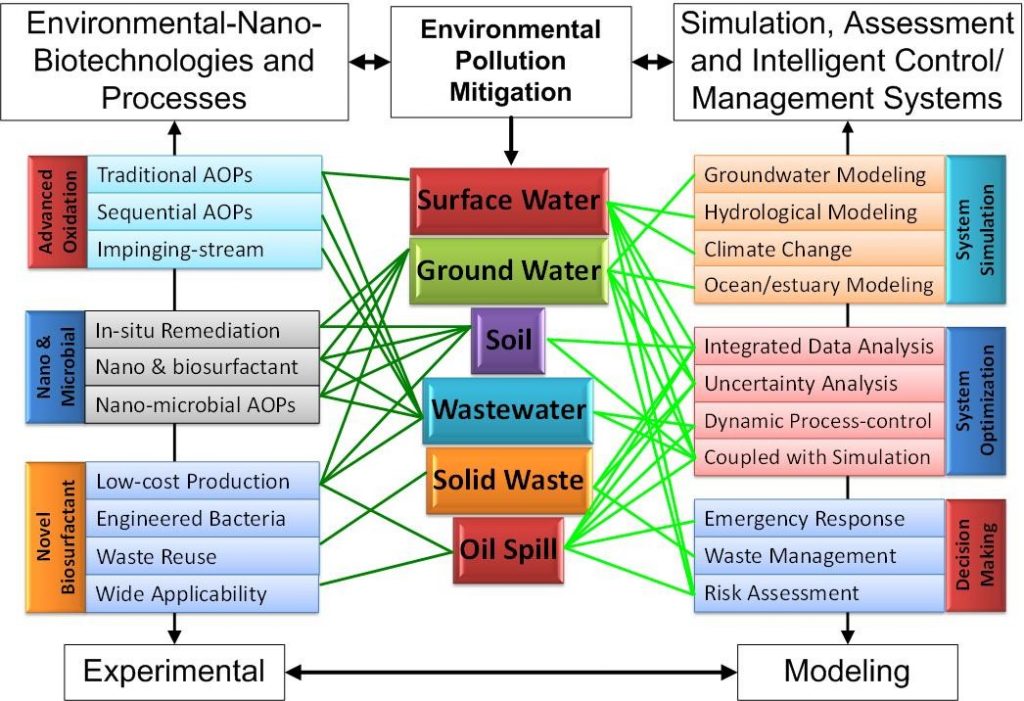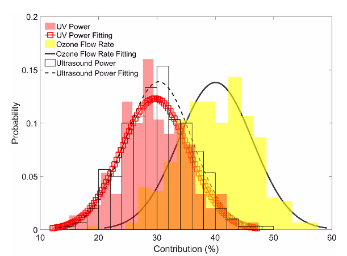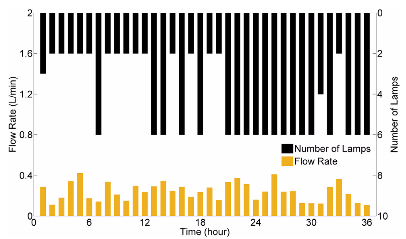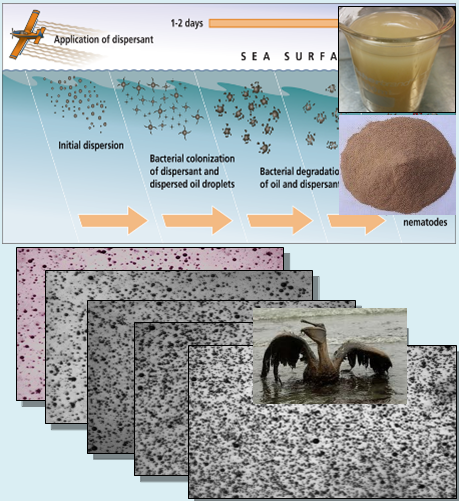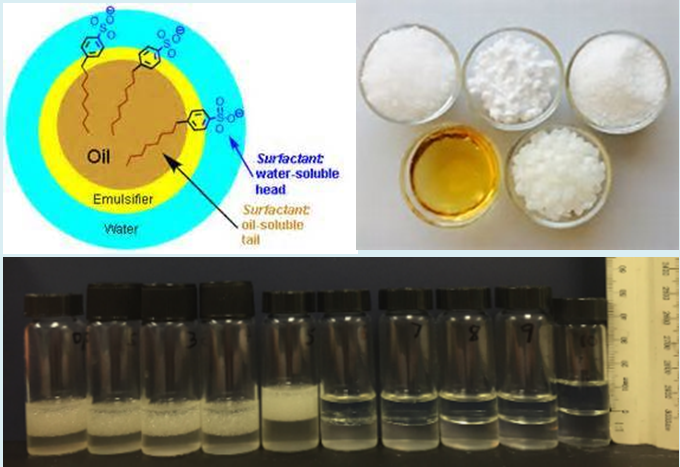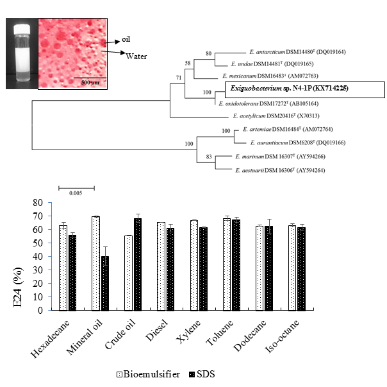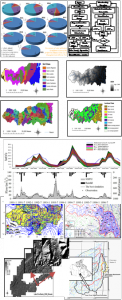NRPOP is recognized worldwide for its pioneering research on persistent and toxic organic pollutants, such as oils and pesticides, and their pollution mitigation in cold regions and harsh marine environments.
NRPOP Research & Development Framework
Theme A: Innovative Environmental-Nano-Biotechnologies and Processes |
A-1: Development of nano-microbial enhanced advanced oxidation processes (EOPs) for wastewater treatment and reuse
The persistent and toxic organics in industrial wastewater have become one of the biggest concerns of public health and water quality. Many of these organics are highly recalcitrant to traditional physic-chemical and biological treatment and may accumulate in the environment. NRPOP lab has developed a series of innovative nano-microbial enhanced EOPs through incorporation of UV/LED, ozonation, ultrasonication, nano-material (catalysts and absorbents), microfluidics*, biosurfactants (by engineered microbial), and impinging stream approaches
to significantly enhance the removal of these pollutants through oxidative destruction and biodegradability enhancement, and to reuse the treated water and recover the resources (e.g., salts). Research efforts have been directed to understanding the mechanisms of the treatment including thermodynamics, kinetics and degradation pathways. The developed EOPs have significant advantages such as compatibility with wastewater matrix (e.g., high salinity), high efficiency on both high and trace level of organics, low energy consumption, no/less-chemical addition. The recovery efficiency of nano-scale materials has been investigated and optimized to minimize the secondary pollution.. Besides traditional organic pollutants, these technologies have been proven to effectively destruct a wide range of emerging contaminants (or micro-pollutants) such as pesticides, pharmaceutical and personal care products (PPCPs), endocrine disrupting chemicals (EDCs), and disinfection by products (DBPs). The research has drawn significant support from and partnership with governments, e.g., Oceans and Fisheries Canada (DFO) and Environment Canada (EC), and industries, e.g., Suncor Energy (former Petro Canada) and American Bureau of Shipping (ABS). NRPOP’s innovative and integrated EOP technologies and the associated process control systems fill the knowledge gap and are promising in the treatment of organic wastewater streams from petroleum, petrochemical, pharmaceutical, pesticide, food processing, and textile industries.
*We are collaborating with manufacturers of microfluidics (e.g., uFluidix).
A-2: Biosurfanctants – a green technology and product with diverse applications
 NRPOP lab has been making continued efforts and playing a leading role in R & D of novel high-effectiveness and low-cost biosurfactants and their mirobial producers and production processes. We have also designed and tested them for diverse applications especially in environmental engineering and petroleum engineering, such as offshore oil spill cleanup, soil remediation, and solid waste composting. Biosurfactants are amphiphilic compounds produced by microorganisms during their growth. As natural product of microbe, in comparison with traditional chemical surfactants, biosurfactants have significant advantages of high surface activity, low toxicity, high biodegradability, and high stability even under extreme conditions. Growing health concerns and environmental awareness as well as the increasingly stringent standards have forced the fast transition of traditional chemical surfactants to biological ones, leading to a fast-growing global market and a research hotspot. NRPOP Lab has made a series of innovative and world-leading achievements in this area and has gained significant attention and support from governments and industries in Canada and worldwide (e.g., USA, Norway, China and Brazil). The representative key technologies and achievements in this area are as follows:
NRPOP lab has been making continued efforts and playing a leading role in R & D of novel high-effectiveness and low-cost biosurfactants and their mirobial producers and production processes. We have also designed and tested them for diverse applications especially in environmental engineering and petroleum engineering, such as offshore oil spill cleanup, soil remediation, and solid waste composting. Biosurfactants are amphiphilic compounds produced by microorganisms during their growth. As natural product of microbe, in comparison with traditional chemical surfactants, biosurfactants have significant advantages of high surface activity, low toxicity, high biodegradability, and high stability even under extreme conditions. Growing health concerns and environmental awareness as well as the increasingly stringent standards have forced the fast transition of traditional chemical surfactants to biological ones, leading to a fast-growing global market and a research hotspot. NRPOP Lab has made a series of innovative and world-leading achievements in this area and has gained significant attention and support from governments and industries in Canada and worldwide (e.g., USA, Norway, China and Brazil). The representative key technologies and achievements in this area are as follows:
A-2.1: New biosurfanctants and novel low-cost and high-yield production techniques
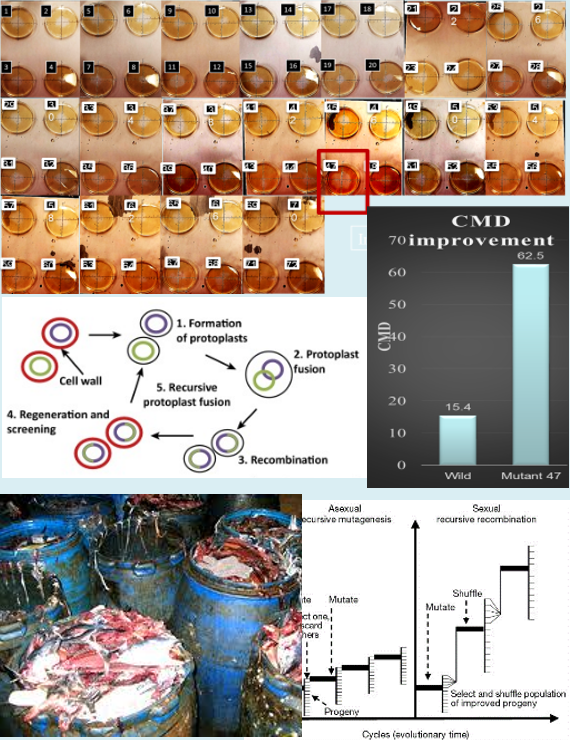 The large-scale commercialization and wide application of biosurfactants have been hindered by their high production cost and low yields, which has been a key technical challenge in the field. The NRPOP lab has sampled and isolated over 110 biosurfactant producers from the environment and especially from the hydrocarbon contaminated environments. They share the common features and advantages of surface tension reduction, emulsion stabilization and flocculation formation. Some of these isolates were discovered as biosurfactant producers for the first time. Mutagenesishas been used to mutate the selected isolates for increasing biosurfactant productivity. The improved mutants were further recursively hybrid using genome shuffling approach to enhance the desired metabolic trait (biosurfactant production) in a manner that can be up to 4 times effective than the conventional mutagenesis. On the other hand, a set of production methods have been developed using unconventional nutrient sources especially organic wastes such as seafood processing waste,leading to effective reduction (>30%) of production cost.
The large-scale commercialization and wide application of biosurfactants have been hindered by their high production cost and low yields, which has been a key technical challenge in the field. The NRPOP lab has sampled and isolated over 110 biosurfactant producers from the environment and especially from the hydrocarbon contaminated environments. They share the common features and advantages of surface tension reduction, emulsion stabilization and flocculation formation. Some of these isolates were discovered as biosurfactant producers for the first time. Mutagenesishas been used to mutate the selected isolates for increasing biosurfactant productivity. The improved mutants were further recursively hybrid using genome shuffling approach to enhance the desired metabolic trait (biosurfactant production) in a manner that can be up to 4 times effective than the conventional mutagenesis. On the other hand, a set of production methods have been developed using unconventional nutrient sources especially organic wastes such as seafood processing waste,leading to effective reduction (>30%) of production cost.
A-2.2: Novel green biodispersants and applications
Biodispersants are biosurfactants with hydrophilic lipophilic balance (HLB) in the range of 10-12 and combine with solvents to help with their distribution in the oil-water interface. They are able to break down oil slicks into small droplets and when provided with mixing energy can be mixed and diluted in the water phase. NRPOP lab has especially cultured some strains (e.g., Rhodococcus erythropolis SB-1A and N6-4P) with strong ability to effectively produce biodispersants. These strains and their products have been characterized in detail. Their productivity and effectiveness have then been further improved with metabolic engineering approaches including mutagenesis and genome shuffling By now, the NRPOP has produced biosurfactant-based biodespersants and successfully tested their capabilities in both batch-scale and wave tank. Meanwhile, they are more environmental friendly due to their no/less toxicity and high biodegradability. They are especially suitable for applications in the offshore or aquatic environments with high risk of oil spills and under cold and harsh environmental conditions. Due to their huge potential for commercialization and innovative eco-friendly features, the research has attracted great interest and support from industry and government. In addition, these biodispersants have been proven effective in cleaning residual oils without arising environmental concerns. The application can be extended to other applications that involves hydrocarbon production, storage, transportation, and utilization.
A-2.3:New green bioemulsifiers and applications
Bioemulsifiers are high molecular weight biosurfactants capable of stabilizing emulsions. NRPOP lab has isolated two excellent bioemulsifier producers, i.e. Halomonas spp. N3-2A and Exiguobacterium oxidotolerans N4-1P, from the offshore environment in the North Atlantic Canada. The latter one is an extremophile which only found in extremely hot or cold environment. It was reported as a bioemulsifier producer in such genus for the first time in the literature. Both isolates have been subjected to metabolic engineering by UV mutagenesis and genome shuffling approaches to improve the yield of bioemulsifiers from the hyper production mutants and hybrids. These mutants and hybrids have been successfully used for bioemulsifier production in batch scale and pilot-scale. The products, green bioemulsifiers (non-toxic and chemical free), can be widely used in pharmaceutical, cosmetic, oil and gas, petro-chemical and agro-chemical industries.
A-3: Enhanced nano-/bio-remediation for contaminated soil and groundwater and remediation system optimization
 A set of novel nano-biosurfactant techniques and the integrated compounds (e.g., zerovalent metals (ZVM) & biosurfactants, carbon nanotube & biosurfactants, and nano-biosurfactants) have been developed by the NRPOP Lab. The produced nano-biosurfactants have higher solubilizing capacity for hydrophobic compounds and lower interfacial tension between oil and water phases than the traditional surfactant solutions. They show stable performance in the natural environment. They have been successfully integrated into the NRPOP’s enhanced soil and groundwater in-situ remediation technologies. Series of multiple scale experiments and applications have resulted in the new discovery of mechanisms of nano-biosurfactant enhanced biodegradation which have been proven as a significant enhancement when compared with traditional soil and ground water remediation approaches. Particularly, the nano-biosurfactant enhanced remediation technologies have shown strong capability and advantages in dealing with the long-term contaminated sites having co-existence of heavy metals and recalcitrant organic pollutants (e.g., hydrocarbons) in cold and harsh environments (e.g., in north Atlantic Canada and Arctic). Such sites have been presented as a long-term challenge for the government and the industry. Furthermore, integrated physical (bench/pilot-scale) simulation and remediation modeling system has led to successful performance prediction and optimization.. It can serve as an effectively support for the remediation practice for contaminated soil and groundwater.
A set of novel nano-biosurfactant techniques and the integrated compounds (e.g., zerovalent metals (ZVM) & biosurfactants, carbon nanotube & biosurfactants, and nano-biosurfactants) have been developed by the NRPOP Lab. The produced nano-biosurfactants have higher solubilizing capacity for hydrophobic compounds and lower interfacial tension between oil and water phases than the traditional surfactant solutions. They show stable performance in the natural environment. They have been successfully integrated into the NRPOP’s enhanced soil and groundwater in-situ remediation technologies. Series of multiple scale experiments and applications have resulted in the new discovery of mechanisms of nano-biosurfactant enhanced biodegradation which have been proven as a significant enhancement when compared with traditional soil and ground water remediation approaches. Particularly, the nano-biosurfactant enhanced remediation technologies have shown strong capability and advantages in dealing with the long-term contaminated sites having co-existence of heavy metals and recalcitrant organic pollutants (e.g., hydrocarbons) in cold and harsh environments (e.g., in north Atlantic Canada and Arctic). Such sites have been presented as a long-term challenge for the government and the industry. Furthermore, integrated physical (bench/pilot-scale) simulation and remediation modeling system has led to successful performance prediction and optimization.. It can serve as an effectively support for the remediation practice for contaminated soil and groundwater.
A-4:Composting technologies and applications
 NRPOP lab has developed and tested several advanced composting technologies for effective treatment of solid waste and producing valuable products for environmental engineering applications.
NRPOP lab has developed and tested several advanced composting technologies for effective treatment of solid waste and producing valuable products for environmental engineering applications.
1) A cost-efficient community-scale composting system has been developed to process the collected organic waste (such as from household, fishery and food processing), which has been converted to stable and mature compost product (e.g., soil conditioner). The parameters of the compositing system and the compost products including temperature, oxygen uptake rate, pH, conductivity, C/N ratio, germination index, moisture, ash content and enzyme activities have been monitored and analyzed.
2) Industrial wastes such as fish wastes and refinery wastes were subjected to composting process to generate unconventional and economic substrate to serve as the nutrients for the production of biosurfactants with much higher market value and wide application in environmental engineering fields.
3) Composting of petroleum contaminated soil or co-composting of industrial solid waste with wastewater treatment sludge can be further enhanced by introducing specially cultured or mutated microbial to remove organic pollutants and reduce the toxicity level of the solid wastes in a cost-effective way.
A-5: Heavy oil fly ash activated carbon (HOFA-AC) production technology and application for water and wastewater treatment
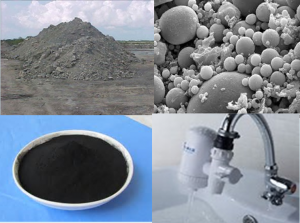 Heavy oil fly ash (HOFA) is a by-product of combustion processes using heavy fuel oil in industrial production such as power plants. The large quantity of HOFA discharge occupy valuable land and cause air pollution problems due to particulate matter (PM) emission. It also contaminates soil and water through deposition and leaching. Exposure to HOFA can cause health issues such as coughing, decreased lung function, skin damage and eye disease. The safe and effective disposal of HOFA has become a pressing need to many regions and countries, especially for those with high energy consumption rates and relying on power generation using heavy fuel oil. Nevertheless, HOFA possesses a great portion of unburned carbon (>60%) based on PM fractions. This high content of carbonaceous matter could be the perfect precursor of valuable activated carbons which only needs an activation step. NRPOP lab developed physical and chemical activation methods and high-effectiveness and low-cost production processes for converting HOFA into activated carbon (HOFA-AC) with high surface area and adsorption capacity. This waste-to-product technology can help significantly reduce the amount of fly ash being dumped and convert waste to valuable absorbents which have been successfully applied in the following areas: 1) treating drinking water as absorbents to remove disinfection by-products (DBPs) and heavy metals (e.g. Arsenic) through case studies in several local communities in Newfoundland, Canada; and 2) integrating with nano-catalysts for industrial wastewater treatment through simultaneous adsorption and photo-oxidation.
Heavy oil fly ash (HOFA) is a by-product of combustion processes using heavy fuel oil in industrial production such as power plants. The large quantity of HOFA discharge occupy valuable land and cause air pollution problems due to particulate matter (PM) emission. It also contaminates soil and water through deposition and leaching. Exposure to HOFA can cause health issues such as coughing, decreased lung function, skin damage and eye disease. The safe and effective disposal of HOFA has become a pressing need to many regions and countries, especially for those with high energy consumption rates and relying on power generation using heavy fuel oil. Nevertheless, HOFA possesses a great portion of unburned carbon (>60%) based on PM fractions. This high content of carbonaceous matter could be the perfect precursor of valuable activated carbons which only needs an activation step. NRPOP lab developed physical and chemical activation methods and high-effectiveness and low-cost production processes for converting HOFA into activated carbon (HOFA-AC) with high surface area and adsorption capacity. This waste-to-product technology can help significantly reduce the amount of fly ash being dumped and convert waste to valuable absorbents which have been successfully applied in the following areas: 1) treating drinking water as absorbents to remove disinfection by-products (DBPs) and heavy metals (e.g. Arsenic) through case studies in several local communities in Newfoundland, Canada; and 2) integrating with nano-catalysts for industrial wastewater treatment through simultaneous adsorption and photo-oxidation.
A-6: Tunable nanostructured electrode and microbial waste-to-energy (MW2e) cell for wastewater treatment and renewable energy generation
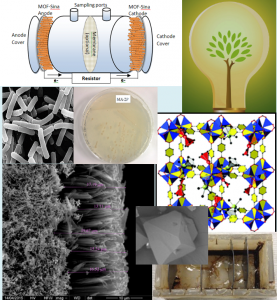 Microbial fuel cells (MFCs) are unconventional microbiological devices well-known for generating “clean energy” – bioelectricity from different waste streams. They can assist in meeting the ever-increasing energy demand and reducing the pollution to the aquatic environment simultaneously. NRPOP Lab has recently developed a novel Microbial Waste-to-Energy (MW2e) cell for converting organic matters in oily wastewater into electricity. To enhance the transfer of electrons from the electrodes and promote the generation of electricity, newly tunable nanostructured electrodes were developed for the first time in the world. These electrodes incorporated metal-organic frameworks (MOFs) and covalent organic framework (COF) with silicon nanowires arrays (SiNA). It is also the first time to introduce biosurfactants (produced by the unique strains discovered and cultured by NRPOP Lab) to facilitate bio-electrochemical reactions. It is a ground-breaking and promising technology leading to extensive applications in many areas and industrial fields such as environment, electricity, power, renewable energy, and nanomaterials.
Microbial fuel cells (MFCs) are unconventional microbiological devices well-known for generating “clean energy” – bioelectricity from different waste streams. They can assist in meeting the ever-increasing energy demand and reducing the pollution to the aquatic environment simultaneously. NRPOP Lab has recently developed a novel Microbial Waste-to-Energy (MW2e) cell for converting organic matters in oily wastewater into electricity. To enhance the transfer of electrons from the electrodes and promote the generation of electricity, newly tunable nanostructured electrodes were developed for the first time in the world. These electrodes incorporated metal-organic frameworks (MOFs) and covalent organic framework (COF) with silicon nanowires arrays (SiNA). It is also the first time to introduce biosurfactants (produced by the unique strains discovered and cultured by NRPOP Lab) to facilitate bio-electrochemical reactions. It is a ground-breaking and promising technology leading to extensive applications in many areas and industrial fields such as environment, electricity, power, renewable energy, and nanomaterials.
A-7: Advanced methods for environmental monitoring and sample analysis
 (1) A simple, cost-effective, and efficient pretreatment method, namely, vortex- and shaker-assisted liquid–liquid microextraction (VSA-LLME) coupled with gas chromatography and mass spectrometry (GC-MS), is developed for determining 16 trace-level polycyclic aromatic hydrocarbons (PAHs) in offshore produced water. The parameters affecting the VSA-LLME performance including solvent volume, ion strength, shaking time, and centrifuge speed were optimized. Under the optimized condition, the enrichment factors range between 68 and 78. The limits of detection were as low as 2 to 5 ng/L. The developed method offers advantages including simplicity of operation, low cast, and high sensitivity.
(1) A simple, cost-effective, and efficient pretreatment method, namely, vortex- and shaker-assisted liquid–liquid microextraction (VSA-LLME) coupled with gas chromatography and mass spectrometry (GC-MS), is developed for determining 16 trace-level polycyclic aromatic hydrocarbons (PAHs) in offshore produced water. The parameters affecting the VSA-LLME performance including solvent volume, ion strength, shaking time, and centrifuge speed were optimized. Under the optimized condition, the enrichment factors range between 68 and 78. The limits of detection were as low as 2 to 5 ng/L. The developed method offers advantages including simplicity of operation, low cast, and high sensitivity.
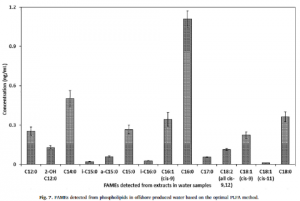 (2) A method based on phospholipid fatty acid (PLFA) analysis for profiling microbial communities in offshore produced water was optimized. The operation parameters affecting final PLFA profiling performance from the solid phase extraction (SPE) purification and fatty acid methyl esters (FAMEs) yielding process were investigated. Four parameters including alkaline reagent, volume of acid for neutralization, time and temperature for FAMEs derivatization were examined. Gas Chromatography-Mass Spectrometry (GC-MS) was used to analyze FAMEs and the method linearities, recoveries of 29 FAMEs during transesterification, detection limits, relative standard deviations were presented. The results provided valuable information for biological reservoir souring control.
(2) A method based on phospholipid fatty acid (PLFA) analysis for profiling microbial communities in offshore produced water was optimized. The operation parameters affecting final PLFA profiling performance from the solid phase extraction (SPE) purification and fatty acid methyl esters (FAMEs) yielding process were investigated. Four parameters including alkaline reagent, volume of acid for neutralization, time and temperature for FAMEs derivatization were examined. Gas Chromatography-Mass Spectrometry (GC-MS) was used to analyze FAMEs and the method linearities, recoveries of 29 FAMEs during transesterification, detection limits, relative standard deviations were presented. The results provided valuable information for biological reservoir souring control.
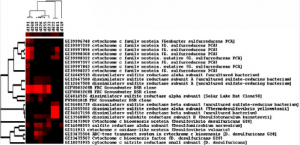 (3) GeoChip microarray is a new generation of functional gene arrays, with ~ 80,000 probes covering approximately > 280,000 gene sequences from > 400 functional gene families involved in carbon, nitrogen, phosphorus and sulfur cycles, energy metabolism, antibiotic resistance, metal resistance and organic contaminant degradation. Such a high-throughput tool has been demonstrated in the NRPOP lab as an extremely robust in study of microbial community functional activity, and link microbial communities to process understanding and control in the composting remediation system.
(3) GeoChip microarray is a new generation of functional gene arrays, with ~ 80,000 probes covering approximately > 280,000 gene sequences from > 400 functional gene families involved in carbon, nitrogen, phosphorus and sulfur cycles, energy metabolism, antibiotic resistance, metal resistance and organic contaminant degradation. Such a high-throughput tool has been demonstrated in the NRPOP lab as an extremely robust in study of microbial community functional activity, and link microbial communities to process understanding and control in the composting remediation system.
A-8: Water Quality Analysis of Underground Reservoirs in Hot and Arid Regions
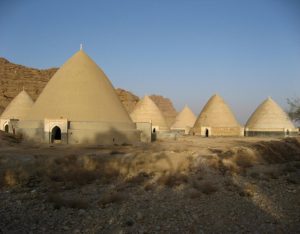 Drinking water resources are limited, and this issue is one of the most important problems in our modern world. Access to clean and safe drinking water is an essential need for all communities. In hot and arid or semi-arid regions, collecting and storing rainwater in underground reservoirs provides a major resource of potable water, particularly in rural zones. Due to the lack of water resources, providing sufficient drinking water is extremely difficult in these regions. In this study, the water quality of underground reservoirs in 6 villages among 20 villages around Khusf City, which is located in a hot and arid region in the South Khorasan province of Iran, is analyzed using physical, chemical, and microbial tests. Additionally, an experimental design method is employed to evaluate the quality of water. The physical and chemical tests show that several parameters such as pH, Total Hardness (TH), Chloride, Sulfate, Nitrite, Nitrate, Calcium, Magnesium, Sodium, Potassium, and Manganese are within an acceptable range of World Health Organization (W.H.O.) standards for drinking water; however, some parameters including Turbidity, Electrical Conductivity (EC), Fluoride, Iron, and Total Dissolved Solids (TDS) are outside of the standard acceptable range. In terms of microbial parameters in 100 ml of the samples, the percentage of Coliforms reaches 77% in the presumptive stage, and 33% in the confirmed stage, which are higher compared to the standards. Also, Faecal Coliform is observed in 11% of the samples. The obtained results indicate that the physical and chemical quality of water in the reservoirs is to a large extent within the acceptable range, while the microbial parameters are not at an appropriate level.
Drinking water resources are limited, and this issue is one of the most important problems in our modern world. Access to clean and safe drinking water is an essential need for all communities. In hot and arid or semi-arid regions, collecting and storing rainwater in underground reservoirs provides a major resource of potable water, particularly in rural zones. Due to the lack of water resources, providing sufficient drinking water is extremely difficult in these regions. In this study, the water quality of underground reservoirs in 6 villages among 20 villages around Khusf City, which is located in a hot and arid region in the South Khorasan province of Iran, is analyzed using physical, chemical, and microbial tests. Additionally, an experimental design method is employed to evaluate the quality of water. The physical and chemical tests show that several parameters such as pH, Total Hardness (TH), Chloride, Sulfate, Nitrite, Nitrate, Calcium, Magnesium, Sodium, Potassium, and Manganese are within an acceptable range of World Health Organization (W.H.O.) standards for drinking water; however, some parameters including Turbidity, Electrical Conductivity (EC), Fluoride, Iron, and Total Dissolved Solids (TDS) are outside of the standard acceptable range. In terms of microbial parameters in 100 ml of the samples, the percentage of Coliforms reaches 77% in the presumptive stage, and 33% in the confirmed stage, which are higher compared to the standards. Also, Faecal Coliform is observed in 11% of the samples. The obtained results indicate that the physical and chemical quality of water in the reservoirs is to a large extent within the acceptable range, while the microbial parameters are not at an appropriate level.
Theme B: Novel Environmental Dynamic Simulation, Integrated Assessment and Intelligent Control/Management Technologies and Systems |
B-1: Environmental emergency response – decision support systems (ER-DSS)
Environmental emergencies are disasters or accidents that can 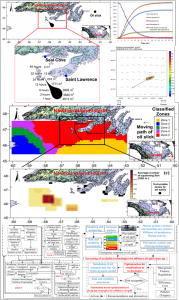 cause severe environmental damage as well as loss of human lives and property. Being prepared for an emergency is critical to mounting a quick and effective response that will minimize negative impacts on the health of people, and the environment. Current decision-making systems are basically static and lack capacities and functions to simulate emergencies affected by the dynamic, complex, and spatial-temporal factors as well as optimize the corresponding responses, due to human response actions, leading to the challenges in providing a comprehensive dynamic decision support to achieve the most prompt, scientific and effective responses. NRPOP Lab has been leading in the field of simulation-optimization coupling, artificial intelligence, uncertainty analysis and multi-criteria decision making as well as their integration techniques. In the recent years, the lab has developed a set of innovative environmental emergency response – decision support systems (ER-DSSs). The ER-DSS primarily targets on integrating the classification, technology screening, and simulation-based optimization for oil spill vulnerability index response and countermeasurements under uncertainties. ER-DSSs can be extended to other water, air and soil pollution issues with certain modifications (e.g., incorporating different pollution and response simulation models). The ER-DSSs can be applied as powerful tools for contingency planning, preparedness training and response management for public sectors (e.g., environmental or harbor authorities) and private users (e.g., petro-chemical plants or complex) who face risks of explosion or accidental release when manage, transportm store, or use hazardous substances and of these substances. NRPOP Lab’s representative techniques and systems in this area include the following:
cause severe environmental damage as well as loss of human lives and property. Being prepared for an emergency is critical to mounting a quick and effective response that will minimize negative impacts on the health of people, and the environment. Current decision-making systems are basically static and lack capacities and functions to simulate emergencies affected by the dynamic, complex, and spatial-temporal factors as well as optimize the corresponding responses, due to human response actions, leading to the challenges in providing a comprehensive dynamic decision support to achieve the most prompt, scientific and effective responses. NRPOP Lab has been leading in the field of simulation-optimization coupling, artificial intelligence, uncertainty analysis and multi-criteria decision making as well as their integration techniques. In the recent years, the lab has developed a set of innovative environmental emergency response – decision support systems (ER-DSSs). The ER-DSS primarily targets on integrating the classification, technology screening, and simulation-based optimization for oil spill vulnerability index response and countermeasurements under uncertainties. ER-DSSs can be extended to other water, air and soil pollution issues with certain modifications (e.g., incorporating different pollution and response simulation models). The ER-DSSs can be applied as powerful tools for contingency planning, preparedness training and response management for public sectors (e.g., environmental or harbor authorities) and private users (e.g., petro-chemical plants or complex) who face risks of explosion or accidental release when manage, transportm store, or use hazardous substances and of these substances. NRPOP Lab’s representative techniques and systems in this area include the following:
A Monte Carlo simulation-based two-stage adaptive resonance theory mapping (MC-TSAM) approach for environmental emergency risk/vulnerability classification;
• A Monte Carlo simulation-integrated rule-based fuzzy adaptive resonance theory mapping (MC-IRFAM) for response technology screening and resource allocation;
• A Monte Carlo simulation based dynamic mixed integer nonlinear programming (MC-DMINP) approach for response process simulation and optimization;
• Newfoundland offshore oil spill emergency response decision support system (OOSER-DSS).
This research have attracted strong interest and continued funding support from governments and industries, such as United Nations Development Programme (UNDP), Natural Science and Engineering Research Council of Canada (NSERC), NL Research & Development Corp (RDC), Fisheries & Oceans Canada (DFO), Environment Canada (EC), Petroleum Research Newfoundland and Labrador (PRNL), Suncor Energy, ExxonMobil, Canadian Association of Petroleum Producers (CAPP), China Ocean Administration and Ministry of Environment, and PetroBras.
B-2: Simulation-optimization coupling approaches and modeling tools for environmental pollution control and resources management
A series of hybrid programming approaches have been developed based on coupling of pollution or treatment process simulation/control, system optimization (linear/non-linear, single/multi-objective, integer, dynamic, fuzzy/stochastic/internal programming) and environmental and human health risk assessment. These approaches can provide feasible and effective expressions of dynamically communicating uncertainties and simulation/assessment results into environmental decision-making processes through simulation-optimization coupling and uncertainty analysis. They also show significant advantages in incorporating integrated data analysis, reflecting the effects of uncertainty, reducing data and computational requirements, and increasing solution effectiveness and robustness when dealing with large-scale and complex environmental problems. They have been successfully employed to complete a number of research and consulting projects funded by governments (e.g., NSERC, EC, City of St. John’s, China MWR, City of Chengdu, and UNDP) and industries (e.g., SaskPower and Nestle) in the areas of water pollution control, watershed management, water resources allocation, waste management, sustainability development, and environmental planning within Canada and beyond.

• Water quality management and nonpoint source pollution control – Monte Carlo simulation aided analytic hierarchy process (MC-AHP) approach has been developed to feasibly and efficiently handle uncertentis in group decision making related in non-point-source pollution management by integrating the beta-PERT distribution, pairwise comparison, and Monte Carlo simulation.A simulation-based inexact two-stage chance constraint quadratic programming (SIDCCQ) has been developed to provide a efficient relation between environmental requirements and cost (penalities or opportunity losses) for supporting decision making in stream water quality management. and a set of nonpoint source (pesticide) pollution simulation and best management practice models (PeCM/PeLM/PeMM) was aimed to simulation pesticide loss through surface runoff and combine it to risk characterization for the evaluation of pesticide-induced health risk.
• Wastewater treatment and reuse – a simulation-based dynamic mixed integer nonlinear programming (SDMINP) approach, an integrated simulation-based process control and operation planning (IS-PCOP) system, and hybrid fuzzy-stochastic-interval analytic hierarchy process approaches (SI-AHP/FS-AHP) has been developed to intelligently plan, control and optimize wastewater treatment and reuse management as well as address the effects of uncertainties judgement. Multi-scale two-stage mixed integer stochastic model for the optimal design of WWTP networks under uncertainty (MSIS-WWN), and multi-agent simulation-optimization coupling for integrated urban water and wastewater treatment and reuse management (ASO-WWM) are developing to reduce the complexity induced by various uncertainties and multiscale nature of the planning process;
• Solid waste management – a resource-oriented solid waste management system for a mixed rural-urban area through Monte Carlo simulation-based fuzzy programming (RSW-MCFP);
• Environmental planning and sustainability – Decision support systems for city/watershed integrated water resources (water quality and quantity) management and planning (IWRMP), and decision-support and planning for rural environmental sustainability (DSRD); etc.
B-3: Surface and ground water modeling and uncertainty analysis approaches and modeling tools
• NRPOP Lab has been conducted a large amount of theoretical research and practical projects in surface and groundwater monitoring, modeling and uncertainty analysis. A number of new or refined data analysis, model parameterization, sensitivity analysis and uncertainty analysis methods have been developed and integrated to effectively reduce input and parameter needs, increase computational efficiency, validity, and mitigate influence of uncertain information on modeling results. These methods have been successfully employed to refine the modeling processes and improve modeling accuracy when applied to well recognized and accepted models (e.g., SWAT,Slurp,Wateflood, Bioslurp, Bio F&T, and UT Chem) for runoff/floods simulation, water management and site remediation systems in Canada (e.g., Manitoba and Saskatchewan) and China (e.g., Sichuan and Inner Mongolia). Some recently developed methods and achievements include: A novel design of experiment (DOE) aided sensitivity analysis and calibration method and a sequential multi-criteria based calibration and uncertainty analysis (SMC-CUA) have been developed and applied for real cases to help parameterization and examine uncertainty throughout the modeling process to improve simulation performance and the reliability in hydrologic modeling and groundwater contamination simulation;
• An innovative response based statistical evaluation method (RESEM) and integrated simulation-based evaluation system for uncertainty propagation analysis (ISES-UPA) have been developed and tested for quantifying the propagated effects and individual/collective contributions of different uncertainties to the influence. They have been effectively applied from statistical downscaling to hydrological modeling under changing climatic conditions;
• Please visit our Arctic Wetland Research and the example project for more details:
Field Investigation and Hydrological Modeling of Sub-Arctic Wetland Hydrology in Southwestern Hudson Bay

